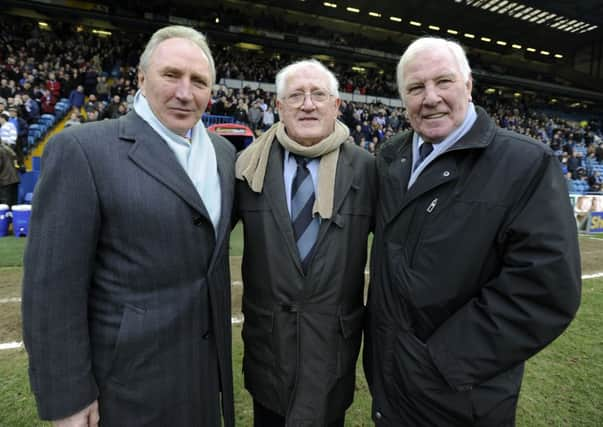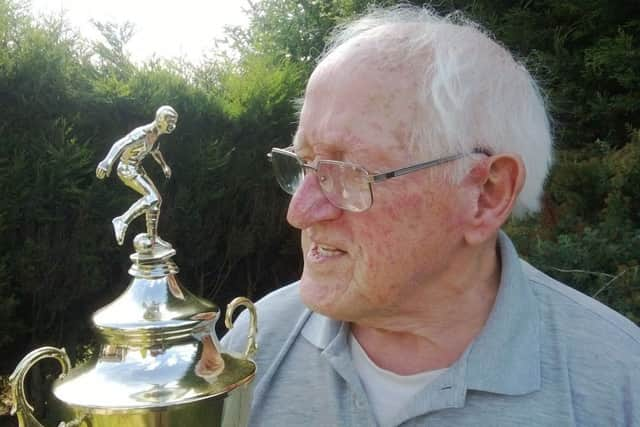Jackie Sewell: The day England were given a footballing lesson at Wembley


The murky archive television pictures reveal an electrifying goal that lights up a grey and misty November afternoon at Wembley.
This is a recording of the match – 60 years ago this week – that ushered in modern football, when the Hungarians gave a display of such superiority the inventors of the game were forced to re-think how it should be played.
Advertisement
Hide AdAdvertisement
Hide AdBut this terrific strike after 13 minutes does not come from Puskás in his pomp, or from any Hungarian. A lightning three-man move from the England goalmouth sees the ball delivered to the feet of a Sheffield Wednesday player in the number 10 shirt sprinting towards the opposing goal. He takes three strides and from the left of the penalty area strikes the ball with his left foot. It scuds low across the grass into the net just inside the keeper’s left-hand post.


Goal to England from Jackie Sewell! It brings his team level at 1-1.
For a moment it seems England may possess the skills to match the Hungarian. On that day in 1953 that belief had history to support it. Never in 90 years had a team from foreign shores defeated us on home turf. But these 90 minutes marked our rude awakening. The scale of the reverse, 6-3, and the magisterial authority of the opposition revealed England to be second rate.
Thanks to Jackie Sewell England’s light briefly flickered. It had been extinguished long before the final whistle. Today Jackie is the only one from that team still alive. Aged 87 he lives in Nottingham, where his professional football career began in 1944.
Advertisement
Hide AdAdvertisement
Hide AdIt sounds a distant time. It was. He was first signed by Notts County and he played for them on Saturday afternoons while for the rest of the week he hacked at the coalface of a pit in Cumbria.His next club was Sheffield Wednesday who bought him in 1951 for a world record fee of £38,500.
Compare what would have been the young Jackie’s life chances with the player who has succeeded him as the world’s most expensive player, Gareth Bale. The Welshman’s football gifts earned him a 100 million euros transfer this summer and a gilded life in Spain where’s he’s rewarded on a scale beyond the imaginings of most ordinary people.
Jackie just put his football boots in a bag, caught a train down to another coalfield and was glad of the opportunity to make a bit more than the average working bloke.
He arrives for our interview at his suburban bungalow driving his silver VW. He is returning from a trip to the local shops and seems spry, wearing loafers and a tweed sports jacket that looks expensive. He does not look as natty as this in a photograph taken at Meadow Lane on the day Sheffield Wednesday signed him. Wearing what looks like an ill-fitting demob suit, the most expensive player in the world stands in the middle of half a dozen awkward-looking Notts County colleagues.
Advertisement
Hide AdAdvertisement
Hide AdJackie’s living room is hung with framed photographs like this that capture different points of a long and varied career. On a table stands a trophy from the Hungarian football association. In 1993, Jackie and two other former members of the England team, Sir Stanley Matthews and George Robb, a Spurs left-winger, attended the 40th anniversary of the game in Budapest. From another room he carries a plastic carrier bag of the fashion boutique variety. Out of it he extracts a thick volume bound in black buckram.
“Here’s a kid’s scrapbook and I was the kid who started it,” he says triumphantly. Inside are the newspaper cuttings that chronicle the earlier part of his career. Jackie, fairly slight in build, played against older, bigger lads. He played in teams mostly made up of relatives and received protection. Something similar applied when he went underground at Haig pit in Kells. There were plenty of Sewells and other relatives to look out for him.
Alf Ramsey once remarked – after seeing Jackie withstand a ferocious tackle – that only a miner would have a physique sturdy enough to resist such a challenge. At Haig they must have known they had an exceptional footballer on their hands. Did they wrap him in cotton wool?
“No,” says Jackie. “I was filling tubs with coal on the pit bottom.” Was the pit the reason for his strength on the football field? “Well, you were always jumping about, you know, nimble.” A cup win for a local youth team brought him to the attention of Notts County. In 1944 they were managed by Major Frank Buckley, one of those unique figures in football who make all sort of unlikely things possible. Later, as manager of Leeds United, he discovered John Charles and brought Jack Charlton to the club).
Advertisement
Hide AdAdvertisement
Hide AdThe old cuttings say Notts took on 17-year-old Jackie for the standard £10 signing-on fee. He doesn’t recall receiving it. So what did they pay him? “A few quid in expenses.” Wasn’t the maximum wage for footballers £20 a week in those days? “They never gave me £20.”
His weekly routine as a teenage prodigy seems scarcely believable these days. At the end of the Friday shift at Haig colliery, Jackie would catch the train from Whitehaven to Carlisle and then via various changes at Leeds or Derby arrive at Nottingham in the early hours.
As his Notts County career progressed, Jackie moved into digs at Bulwell five miles away. It was handier for Bestwood Colliery where he continued to work as a pit-man, later switching to Linby Colliery.The statistics show that on the pitch he was a goal machine – 97 in 178 games for Notts County, 92 goals in 175 games during his four years at Sheffield Wednesday.
The next move to Aston Villa brought him an FA Cup winners’ medal in 1957. Villa controversially defeated the Busby Babes of Manchester United after winger Peter McParland scored following a doubtful shoulder-charge on the goalkeeper Ray Wood which broke his cheekbone.
Advertisement
Hide AdAdvertisement
Hide AdJackie finished his playing career in England at Hull City and then, aged 33, took his wife Barbara and son Paul to Africa and the City of Lusaka FC in the Rhodesia and Nyasaland football league.He settled there, built a multi racial team and then in 1964 when the country became Zambia, was chosen to be captain of the national team.
Today he is slightly rueful about what happened on that day at Wembley 60 years ago. Six members of the England team never played for the side again, although he was not one of them.
History aside, the Hungarians had to be the favourites that day. They were the Olympic champions and were on a 24-game unbeaten run. They had 35 shots on goal, England had five.
Did it revolutionise the way we played the game? Not immediately. In May the following year in Budapest the score was Hungary 7, England 1.
Advertisement
Hide AdAdvertisement
Hide AdBut lessons had been learnt. The centre-forward play of the deep lying number 9, Nandor Hidegkuti, was noted by a rising English player called Don Revie who put his version into practice with the so-called Revie Plan at Manchester City.
In the mid-1950s, what with Suez and all that, there was much hand-wringing about the claim that we had lost an empire and failed to find a role in the world. Defeat at Wembley was added to the list of things denoting national decline.
The television commentator in the archive recording of that match was Kenneth Wolstenholme.
The same man who 13 years later concluded another England commentary at Wembley with, “They think it’s all over – it is now!”
Advertisement
Hide AdAdvertisement
Hide AdWinning the World Cup in 1966 may have been a false dawn. Today, as in 1953, we struggle to find English players with the technique, athleticism and vision to match the best players in the world.
But so far as the Hungarians are concerned, we have the last laugh. Their coach Sandor Egervari recently resigned after his team lost 8-1 to the Netherlands, the heaviest defeat in the country’s history.
Hungary ended up third in group D in the World Cup qualifiers and will not be going to the finals in Brazil.
Puskás’s fame lives on today
Puskás was diagnosed with Alzheimer’s in 2000, died in 2006 and received a state funeral.
Advertisement
Hide AdAdvertisement
Hide AdOpposite Budapest cathedral where Puskas lies, is a shop that sells souvenirs and is dominated by images of him in his playing days.
He appears on crockery, the national flag, clothing, postcards, even wine – one called 6:3 after the Wembley victory.
Given that his playing career in Hungary ended before the uprising against the Russians in 1956, before continuing in Spain, it’s extraordinary how he endures as a national hero.
The equivalent in England would be to see the face of Stanley Matthews, Tom Finney or Denis Compton in High Street shop windows today.